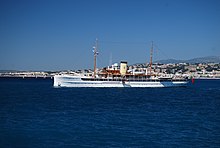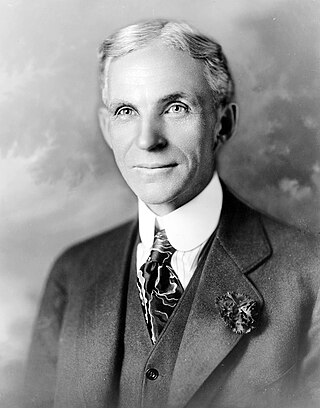
Henry Ford was an American industrialist and business magnate. As the founder of the Ford Motor Company, he is credited as a pioneer in making automobiles affordable for middle-class Americans through the system that came to be known as Fordism. In 1911, he was awarded a patent for the transmission mechanism that would be used in the Ford Model T and other automobiles.
Dodge is an American brand of automobiles and a division of Stellantis North America, based in Auburn Hills, Michigan. Dodge vehicles have historically included performance cars, and for much of its existence Dodge was Chrysler's mid-priced brand above Plymouth.

The Brass Era is an American term for the early period of automotive manufacturing, named for the prominent brass fittings used during this time for such features as lights and radiators. It is generally considered to encompass 1896 through 1915, a time when cars were often referred to as horseless carriages.

Grosse Pointe refers to an affluent coastal area next to Detroit, Michigan, United States, that comprises five adjacent individual cities. From southwest to northeast, they are:
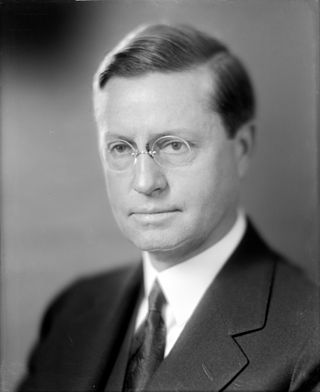
Roy Dikeman Chapin Sr. was an American industrialist and a co-founder of Hudson Motor Company, the predecessor of American Motors Corporation. He also served as the United States secretary of commerce from August 8, 1932, to March 3, 1933, during the final months of the administration of President Herbert Hoover.

John Francis Dodge was an American automobile manufacturing pioneer and co-founder of Dodge Brothers Company.

Graham-Paige was an American automobile manufacturer founded by brothers Joseph B. Graham (1882–1970), Robert C. Graham (1885–1967), and Ray A. Graham (1887–1932) in 1927. Automobile production ceased in 1940, and its automotive assets were acquired by Kaiser-Frazer in 1947. As a corporate entity, the Graham-Paige name continued until 1962.
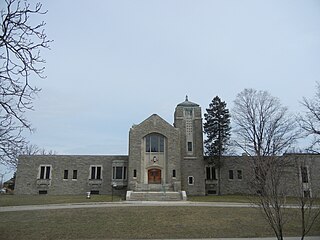
Woodlawn Cemetery is a cemetery located at 19975 Woodward Avenue, opposite the former Michigan State Fairgrounds, between 7 Mile Road and 8 Mile Road, in Detroit, Michigan.

The Music Hall Center for the Performing Arts is a 1,731-seat theatre located in the city's theatre district at 350 Madison Street in Downtown Detroit, Michigan. It was built in 1928 as the Wilson Theatre, designated a Michigan State Historic Site in 1976, and was listed on the National Register of Historic Places in 1977.

Horace Hatcher Rackham was one of the original stockholders in the Ford Motor Company and a noted philanthropist.

Alexander Young Malcomson was a coal dealer from Detroit, Michigan, who bankrolled Henry Ford's first successful foray into automobile manufacturing: the Ford Motor Company.

USS Nokomis (SP-609) was a yacht purchased by the U.S. Navy during World War I. The yacht was purchased from Horace E. Dodge of Detroit, Michigan, after he had the yacht luxuriously fitted out but before he could make use of his second Nokomis — the first having already gone into service.

In the United States, the automotive industry began in the 1890s and, as a result of the size of the domestic market and the use of mass production, rapidly evolved into the largest in the world. The United States was the first country in the world to have a mass market for vehicle production and sales and is a pioneer of the automotive industry and mass market production process. During the 20th century, global competitors emerged, especially in the second half of the century primarily across European and Asian markets, such as Germany, France, Italy, Japan and South Korea. The U.S. is currently second among the largest manufacturers in the world by volume.

Matilda Dodge Wilson was an American politician and heiress who was the 43rd Lieutenant Governor of Michigan. Ranked as one of the wealthiest women in the world, she was the widow of John Francis Dodge, who co-founded the Dodge motor car company in Detroit with his brother Horace Elgin Dodge. She co-founded the Oakland campus of Michigan State University, now Oakland University, with her husband Alfred Wilson, and John A. Hannah. The new university was built on her 1,400-acre (5.7 km2) estate, Meadow Brook Farms.

Anna Thompson Dodge was a Scottish-American socialite and philanthropist, one of the richest women in the world at the time of her death.
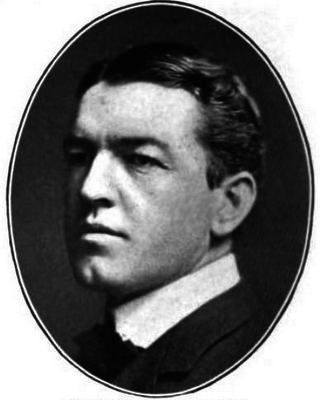
Frederic Latta Smith was a pioneer of the automobile business. He was one of the founders of the Olds Motor Works in 1899 and of General Motors Corporation in 1908. He was also the president of the Association of Licensed Automobile Manufacturers in its early years.

John Simpson Gray was a candymaker, business man, and banker from Detroit. He was also an original investor in and the first president of the Ford Motor Company.

Raymond Thomas Baker was a wealthy United States businessman who was Director of the United States Mint from 1917 to 1922.

Rose Terrace was a private home located at 12 Lake Shore Drive in Grosse Pointe Farms, Michigan. Built in 1934 by Anna Dodge, widow of automobile pioneer Horace E. Dodge, it was designated a Michigan State Historic Site in 1971 and listed on the National Register of Historic Places in 1971. Despite this, the house was demolished in 1976.
Events from the year 1920 in Michigan.

